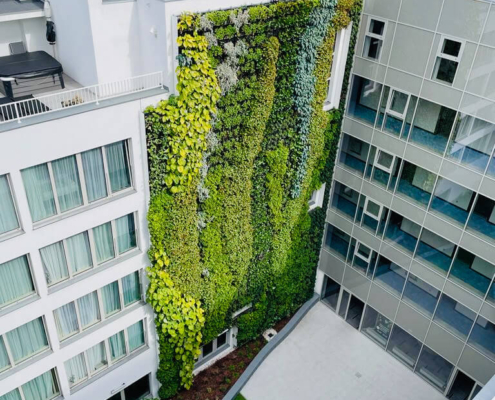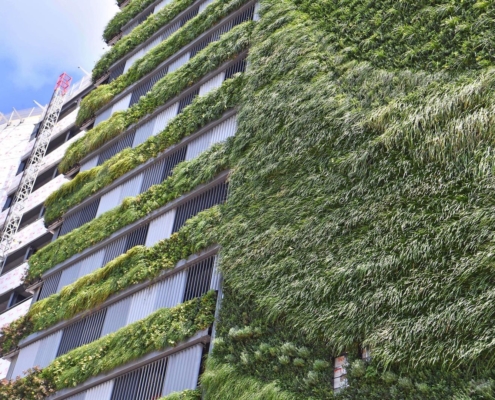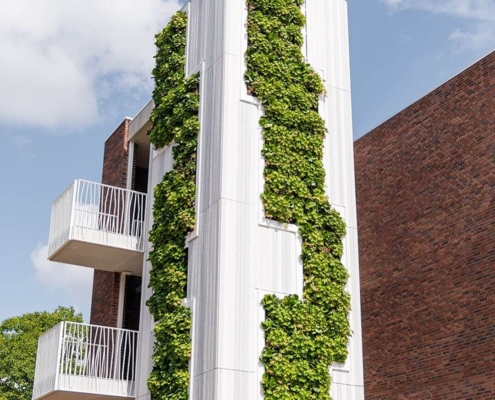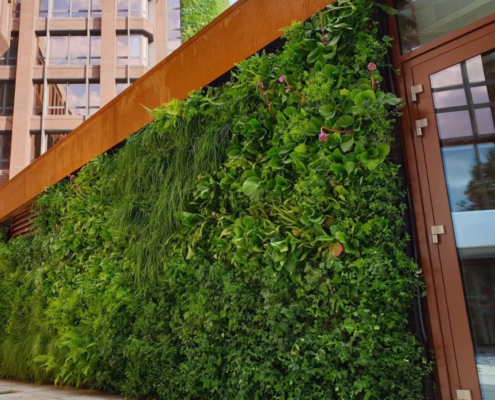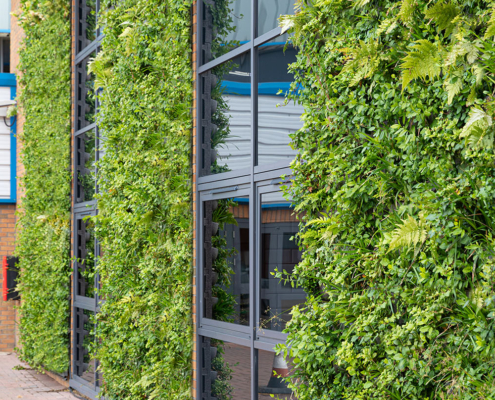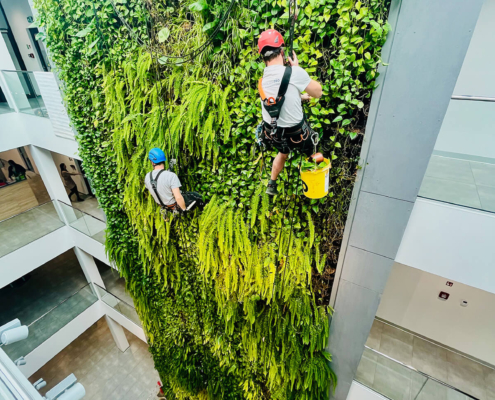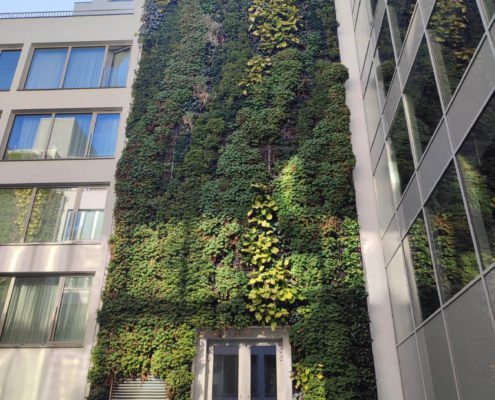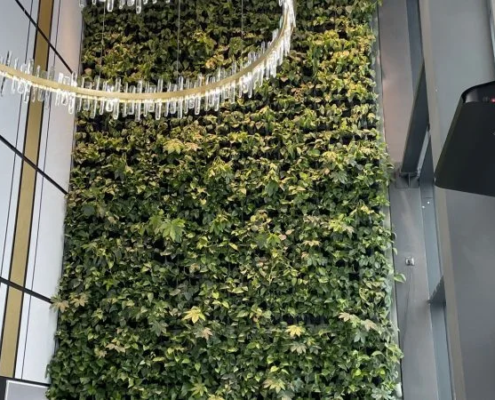Vertical gardens - Green walls that transform spaces
Vertical gardens, also known as green walls, are a modern solution that is gaining popularity in cities and residential spaces around the world. Created with aesthetics in mind, as well as an eco-friendly approach, living walls is a way of decorating buildings with plants that not only improve the appearance of facades, but also bring health and environmental benefits. Thanks to special structures placed on the walls of buildings, plants can grow vertically, creating unique and green surfaces. These types of walls are not only an eye-catcher, but also have ecological and health functions, forming an important element in the green architecture of cities.
What are vertical gardens and how do they work?
Vertical gardens are an innovative solution that allows plants to be embedded in special modular systems that are attached to the walls of buildings. These types of structures can contain a variety of plants, such as climbers, succulents, mosses or shrubs, which are suitably adapted to the environment. The primary purpose of vertical gardens is to create a space with plants on a vertical surface, instead of traditional horizontal gardens. Their operation is based on an irrigation system and a structure that provides adequate air circulation and support for the plants. With proper care and plant selection, vertical gardens effectively purify the air, regulate humidity and have a positive impact on the mental and physical health of the inhabitants.
Health and environmental benefits of vertical gardens
Vertical gardens offer a number of benefits for both health and the environment. Firstly, plants on living walls effectively purify the air, removing pollutants such as carbon dioxide, dust or toxins. As a result, indoor or ambient air quality improves, which has a positive impact on the health of building occupants and users. In addition, vertical gardens increase oxygen levels in the air, which improves mood and concentration. Vegetation on walls also helps to regulate indoor temperature and humidity, providing an optimal microclimate. In cities, on the other hand, where air pollution is often at high levels, vertical gardens act as air filters, improving the quality of life for residents and contributing to the fight against smog.
Why invest in vertical gardens?
Investing in vertical gardens is an excellent way to improve the aesthetics of spaces, both in cities and private homes. Green architecture, or the use of plants in building projects, is one of the most important trends in modern design. Thanks to living walls, any place can gain in attractiveness and at the same time gain in functionality, improving air quality, acoustics and microclimate. Investing in vertical gardens is also a step towards more sustainable urban development, where concrete and steel surfaces are replaced by natural elements. In addition to their aesthetic value, vertical gardens also have eco-friendly properties, improving biodiversity and helping to combat climate change. They are also a great solution for offices, restaurants and other commercial spaces where the health of employees and visitors is important.
What plants work best in vertical gardens?
Selecting the right plants for vertical gardens is a key aspect of their functionality. The choice of plants depends on the location where they will be installed and the climatic conditions there. Vertical gardens often use plants that are resistant to changing weather conditions, such as mosses, climbers, grasses, succulents or perennials. It is also important that the plants have air-purifying properties, for example by absorbing carbon dioxide and other pollutants. Plants for vertical gardens should be easy to care for, resistant to disease and pests, and not require a lot of root space as they grow in modular systems. The selection of suitable species can also depend on the objectives to be achieved, such as improving acoustics, increasing biodiversity or creating aesthetic decoration.
Benefits of a vertical garden in your home or office
Vertical gardens in private spaces such as homes, flats or offices are a great way to improve the quality of life and work. In offices, plants on living walls increase productivity, reduce stress and improve concentration. Vertical gardens in homes create a cosy atmosphere, improving the microclimate and also provide better air quality. Plants help to combat dry air by improving indoor humidity. With vertical gardens, it is possible to create a green oasis in the heart of the city that promotes relaxation and well-being. In addition, such an element in a space gives it a unique character and style that can be adapted to different aesthetic preferences.
What are the costs and requirements for installing a vertical garden?
The installation of a vertical garden involves several steps that need to be planned in order to achieve a satisfactory result. The costs depend on many factors, such as the type of plants, the design of the system, the area where the wall will be installed and the method of irrigation. Installing a vertical garden requires proper preparation of the wall, selection of the irrigation system and ensuring that the plants have the right amount of light. In addition to the installation itself, it is worth factoring in the maintenance costs to ensure that the plants have the optimum conditions to thrive. Vertical garden installation work can be carried out both indoors and on external facades, which affects the choice of technology and plants. It is therefore worth consulting specialists who can help you choose the best solutions.
Green architecture in cities - the role of vertical gardens
In cities where green space is limited, vertical gardens are becoming an effective solution for space management. Green architecture is the answer to the problem of air pollution, noise and lack of biodiversity. Plants on living walls not only improve the aesthetics of buildings, but also perform an ecological function by filtering polluted air. Thanks to vertical gardens, cities can become greener, promoting the health and comfort of their inhabitants. This type of solution supports the fight against global warming, improves the microclimate, and contributes to more places for rest and relaxation.
Vertical garden care - how do you look after your green wall?
The care of vertical gardens is a key element in ensuring their longevity. Regular watering, pruning plants and monitoring their health are essential steps to keep your garden in good shape. It is also a good idea to monitor your irrigation system to ensure that plants are getting the right amount of water. Professional maintenance ensures that vertical gardens will look beautiful and healthy for many years, pleasing the eye and improving the air quality of the environment.
Comprehensive range of vertical gardens - Realise your green wall with Green Facades
Green Facades is a company specialising in the design, installation and maintenance of vertical gardens. We offer a comprehensive service including consultation, plant selection, irrigation system design, installation and regular maintenance. Our experience with green walls allows us to create unique designs that fit perfectly into any space. Trust our specialists to create your own green oasis that will benefit you for years to come.

